
- Home
- Memories
- Scrapbook ▽
- Topics ▽
- People ▽
- Events
- Photos
- Site Map
- Timeline
Page updated 10th November 2013
Return to Industrial Exeter
Go
directly to:
City Brewery - Commercial Road
St Annes Well Brewery - Lower North
Street
St Thomas Brewery - Haven Banks
Northernhay Brewery - New
North Road
Well Park Brewery - Willey's
Avenue
Heavitree Brewery - Church
Street
Minor
Breweries
Brewing in Exeter goes back more than a thousand years to Saxon times, and was initailly carred out in the monasteries and priories. The first mention of brewing in Exeter can be traced back to 1248 when city records noted "Also, if any of the Tenants of the said Dean and Chapter being Bakers or Brewers, are to be punished for breach of the Assize in the Pillory or Tumbrel, the same on the request to the Mayor to be done within the City." (Izacke) An assize is a statute regulating the weight, measure, and proportions of ingredients and the price of articles sold in the market. This is the 13th century version of trading standards. During this period, brewing would have taken place on the premises.
In 1393, Richard II decreed that ale tasters be appointed to ensure quality from the brewers. In 1487, ale connors, or tasters were appointed by the city to examine whether the brewed beer was good and wholesome. (Jenkins)
The Chamber laid down strict responsibilities for the Mayor and other city functionaries. The Mayor was to "...... give to the Brewers the Assise of their Drink, and to set reasonable Prices for and upon the same." (Hoker)
The office of the scavenger was "Also to view and search whether any Brewer, Baker, or other Person, have their Ovens, Furnaces, Chimnies, or Backs, ruinous and in Danger and Peril of Fire." (Hoker)
In the middle of the 17th century, Robert Vilvaine, a doctor thought that good beer was important enough to encourage and also be a way of funding the Free Grammar School. "He likewise purchased of the Mayor and Chamber, for a term of 999 years, a piece of ground, in Exe Island, on which he built a large Brewhouse, with a Malthouse adjoining, called the Public Brewhouse, which he gave to the Chamber...." (Jenkins)
In 1653 Simon Snow's will stated "I give and bequeath to the Corporation of the city of Exeter, and their successors for ever, all that brewhouse and malthouse, called the Common Brewhouse, lately erected near the Duckingstool Mills, in Exe Island" (Jenkins)
The Duckingstool Mill became known as the Round Tree Mill. The City Brewery, would appear on the site of the Common Brewhouse.
Ale -
a beer made with malt,
water and yeast. The yeast prefers a warmer temperature than yeasts
used for lager beer. Has a sweet taste.
Beer - generic beer made
from malt, hops, water and yeast. Hops came from Flanders in Tudor
times - they give the beer a bitter taste, and it keeps longer than ale.
Bitter - dating from the
early 19th century, bitter is a type of pale ale. There are three
types, ordinary bitter, best or regular and premium.
India Pale Ale - an October
ale with added hops that found a good export market to British India.
Lager - beer brewed with
bottom-fermenting yeast strains at a colder temperature than ale.
Mead - Mead is produced by
the fermentation of honey, water, yeast. Fruit, herbs, and/or spices
can be added.
Pale Ale - was perfected by
the 1820's by using ale yeast and pale malts. The breweries of Burton
on Trent were especially good at producing it.
Pils - A bottom-fermented
light beer with a strong taste of hops.
Porter - introduced in the
mid 18th century, porter was a blend of three types of beer, and often
called 'entire'. London porters liked drinking it, hence the name. No
longer brewed.
Stout - deriving from stout
porter beers, the best examples being Guinness, Mackeson and Murphy's.
│ Top of Page │
On 15th September 1760, a lease was agreed by the Mayor, Bailiffs and Commonalty of the City of Exeter to Richard Densham who built a cellar and warehouse on the site beside the Common Brewhouse. Situated on the old Exe Bridge, the site it had a leat running behind and the river in front. Richard Densham went into partnership in 1786 with Samuel White and over the next few years, the brewery took on other partners. An advert in Andrew Brice's Old Exeter Journal of July 1776 gives the proprietors of the Exeter Brewery as Mary Densham and Elizabeth White. It refers to the late partnership and lists the products and prices per hogshead from the brewery. This was a brewery supplying local inns, taverns and large households and individuals. The first lease to mention the City Brewery was dated 1801.
In 1833 the brewery was growing, using the common method of acquisition, and they purchased the St Thomas Brewery (Malthouse), which had existed at Shooting Marsh Stile from 1789. The St Thomas Brewery was both a brewery and malthouse - the building is now the Malthouse family restaurant and pub. Then, in 1834, the partnership of Messrs Benjamin Salter, Thomas Owen Snr and Thomas Owen Jnr was formed. In 1844 the Exeter Brewery in Mermaid Yard was acquired. It was in 1845 that Benjamin Salter sold his interest in the brewery to John Evomy Norman. Various other partnership changes occurred with death and individual bankruptcy. Walter Pring, the second and last major player in the formation of the brewery, became a partner in 1865, forming Norman and Pring. It wasn't until July 1911 that the brewery became a limited company.
The Commercial Road premises was a prominent site on the old Exe Bridge, overlooking the river. Cellars, parallel with the road contained large vats of 310 barrel capacity for storing stout and porter. From 1454, an English barrel contained 36 gallons of beer or 32 gallons of ale giving 11160 gallons per vat. The vats were removed in the 1920's and replaced with glass-lined conditioning tanks for the increasing bottled beer trade. A bottling store between Commercial Road and Frog Street was also commissioned in the 1920's, followed in 1937 by the first automatic bottling plant.
Clean as a Whistle!
Mr
Cyril Brown recalled in the Express & Echo, of when in the
1920's he worked for the City Brewery. He normally worked as a chimney
sweep, but he would work for the City Brewery to shovel the barley
residue out of the giant mash tuns. He had to enter the tun after the
liquid had been drained and shovel out the contents as it was still
steaming hot, into waiting farm carts. The residue was fed to cattle.
When he was finished, he would emerge, pouring with sweat, but as clean
as a whistle. As good as turkish bath!
For a thousand years, Exeter's mills were driven by water wheels installed in the leats. The City Brewery was no exception, as its machinery was driven by two water wheels. In 1929, one of the wheels was replaced by a turbine and generator - the second wheel operated until 1953. Water for the brewery was supplied from three wells until the 1950's when water was taken from the public supply.
In 1943, St Anne's Well Brewery and Norman and Pring merged. In 1955, Whitbread made an alliance with Norman and Pring, when the Exeter brewery became an umbrella brewery of Whitbread for sharing marketing and distribution. In 1962, Whitbread made an offer of £1.3 million to take over Norman and Pring, along with their 168 public houses, which was accepted. In 1967, Norman and Pring (part of Whitbreads) amalgamated with another Whitbread brewery, Starkey, Knight & Ford and relocated to Tiverton, and the City Brewery premises were put up for sale. In July of the same year, fire raged through the brewery, and 30ft flames leapt through the roof. The fire service put the cause down as sparks from oxy-equipment that was being used to dismantle the vats. The building of the Exe Bridge road system in the early 1970's saw the whole area demolished and the leat that drove the water wheels filled in, leaving grass, pavement and road covering the old breweries site.
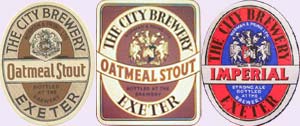
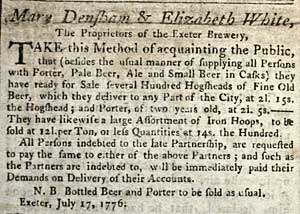 A
1776 advert in the Old Exeter Journal.
A
1776 advert in the Old Exeter Journal.
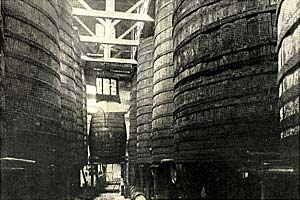 The wooden vats from 1840, removed
in the 1920's
The wooden vats from 1840, removed
in the 1920's 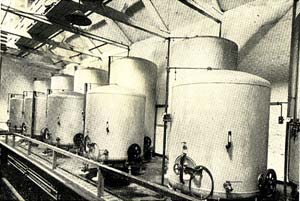 The glass lined vats installed in 1938 in the same building.
The glass lined vats installed in 1938 in the same building.
│ Top of Page │
The birth of St Anne's Well brewery can be traced back to before 1824, when Messrs. Harding and Richards where engaged in brewing and malting in Cowick Street, St Thomas. In 1828, they moved to the Barnstaple Inn, Lower North Street, already established as a coaching inn, to set up a brewery. They continued brewing from the inn, probably supplying local inns and individuals. W J Richards also owned the malthouse (now Ginos Restaurant) on the city wall in Bartholomew Street and was in a position to supply the brewery with its malt. Expansion occurred in 1852 when Harding & Richards purchased from Mr Crockett his wine and spirit business in Paul Street. The takeover was advertised in the Exeter Flying Post with two announcements.
"MR CROCKETT In retiring from the wine and spirit business, which he has for so many years carried out in this City, begs to thank his numerous Friends for their kind support, and to introduce to them, as his successors, Messrs. Harding and Richards, for whom he solicits a continuance of their patronage and support. Paul Street, Exeter 12th May, 1852"
"MESSRS.
HARDING AND RICHARDS Having succeeded to the
old-established Business of Mr. Crockett, beg most respectfully to
solicit the support of their friends and the Public, assuring them that
it will be their constant endeavour to preserve unimpaired the high
character which, for so many years has distinguished their predecessor,
in the selection of the Purest and Best Wines and Spirits. 12th
May, 1852"
The premises in Paul Street is now Las Iguanos. The business used cellars both below the building and across the street, under the Royal Albert Memorial Museum. When the museum was built, the cellars were preserved, and a tunnel was built that crossed under the street, linking the two sets of cellars. A stone was placed with the inscription, "This tunnel was built on the construction of the Albert Museum 1869 by Harding Richards, Wine Merchants". The tunnel was eventually bricked up, and Harding and Richards, reverted to using only the cellars below the shop. The firm also used cellars under the Lower Market from 1872, until June 1953 when the bombed Lower Market was redeveloped, and the bonded store moved to Haven Banks. The Lower Market cellars were the largest private bonded store in the West of England.
The brewery took on another partner and became Harding, Richards & Thomas in 1875. Growing markets required a new brewery, and in March 1878, Harding, Richards and Thomas opened a modern plant, in the old stable yard of the Barnstaple Inn. Its main entrance was from a road next to the Rougemont Hotel, into the top of the building. It also had its own siding from the railway. The brewery was fed from the malt store in the roof, using lifts that were powered by a steam engine. The malt was fed into a hopper and on to the crushing mill, before entering the mash tub below. From the mash tub, the malt passed into a large copper and heated with steam. It then entered the hop back before the liquid was pumped into a cooler. The wort was then fermented in one of a dozen, 47 barrel capacity vats, below the cooling room. After fermentation, the liquid was run off into barrels, ready to be delivered by road or rail.
The firm became a public company in 1889 and was renamed St Anne's Well Brewery Company Ltd. It was named after St Anne's Well, the water supply for the brewery, which was piped by gravity alongside the London & South Western Railway line.
It was in 1943 that the Financial Times announced that St Anne's Well Brewery was to be merged with Norman & Pring. In 1966, St Anne’s Well Brewery was closed and in 1968 William Chudley and Sons who were printers, purchased the site. In 1980 the chimney was removed.
Dark Times
In 1994 an electrician
was called to find out why the light in one
of the clockfaces in the Clock Tower wasn't very bright. He found an
empty, 80 year old Guinness bottle dating from 1913 blocking the light
through the translucent clockface. The Guinness had been bottled at St
Anne's Well Brewery, and had been left by a previous workman.
The building was converted into offices, a restaurant, fitness centre and pub in 1989. The new pub, named St Anne's Well, was opened with local rock band Cut Loose, entertaining the customers. The pub was very quickly christened Stans. It seemed to have a bright future, but that fickle thing, fashion intervened and it was subject to name changes and makeovers over the next few years. It became known as the Fizgig and Firkin and the Fizgig, and even brewed its own beer, once again. It closed in 2001, only to reopen as Starz bar and restaurant. The building is very large and a good part of it has been converted into high class apartments.
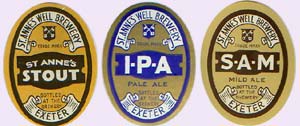
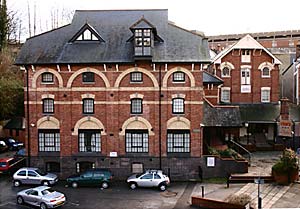 St Anne's Well Brewery
St Anne's Well Brewery
 Chumley's cellar in the 1950's
Chumley's cellar in the 1950's
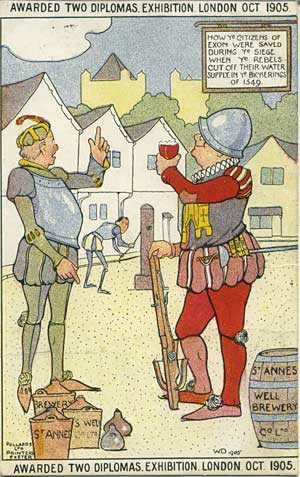 A
postcard advertising St Annes Well Brewery from 1905.
A
postcard advertising St Annes Well Brewery from 1905.
│ Top of Page │
Purpose built in 1789 as a brewery and cellar by the St Thomas Brewery. It was taken over in 1833 by the City Brewery on the opposite bank of the river. Brewing ceased in 1850 and the premises underwent changes over the ensuing years to increase its malting capacity. The St Thomas Brewery also had premises in Okehampton Street, close to where the present Royal Oak is situated. The malthouse closed in 1949, and became a bonded warehouse. The building was converted into a family restaurant and pub called the Malthouse, in 1995. For a fuller history see Malthouse
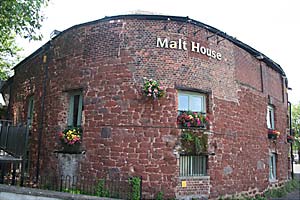 The
Malthouse, formerly the St Thomas Brewery
The
Malthouse, formerly the St Thomas Brewery
│ Top of Page │
Historically, the Northernhay Brewery was a late starter in the city. The premises originally opened as the Devon and Exeter Foundry, run by Charles Coldridge & Sons, in 1840, just after New North Road had been cut, opening up this part of the city. At the death of Charles Coldridge in 1845, the business was put up for sale.
The premises were taken over by the Northernhay Brewery run by John Hyett. Trading through to the late 1850's, it is probable that the Hyett's were responsible for placing the 3 ft long cast-iron sphinx statue on the pediment of the building with the trademark 'Puritas Viresque' (pure and strong) cast along its base. In 1869, the Bristol brewery of Charles Garton Russell and Co. used the building as a brewery store - the coming of the railway to Queen Street gave them the use of sidings for transporting their products. The store supplied locally via horse and cart or further afield to Okehampton, Barnstaple, Ottery St Mary, Seaton and Torbay by rail. They adopted the sphinx as their logo, except they reversed it on adverts. In 1900, the Anglo Bavarian Brewery took over the premises - however, their tenure was short lived and the premises were converted for tent, marquee and tarpaulin manufacturing. Most people will remember the site of the Northernhay Brewery as Reid & Lee, the garage. The building was demolished in November 1991 and Longbrook House constructed to house the local Inland Revenue.
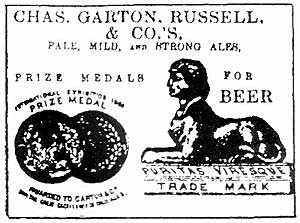 Advert
for the Northernhay Brewery
Advert
for the Northernhay Brewery The cast iron Sphinx on Longbrook House
The cast iron Sphinx on Longbrook House
│ Top of Page │
Purpose-built in 1870 by the partnership of Thomas Gould Pidsley, his brother Hayward Gould Pidsley and brother-in-law Thomas Pearman Stevens, the Well Park Brewery was situated in Willey's Avenue, opposite the railway embankment. Built of brick, the brewery would have incorporated the latest ideas for beer production. Hayward Pidsley retired in 1885, and in 1887 Thomas Stevens sold his interest to Alfred Ross and renamed the firm, Ross & Pidsley.
A promotional leaflet printed in 1888, stated "We respectfully draw attention to the facilities offered for obtaining our celebrated ales and stout in patent, screw-stoppered bottles which are so much preferred by reason of their being easily opened." The leaflet went on to say that the stout had "great strengthening properties" and was "recommended for the use of invalids". Double stout could be purchased for 3 shillings a dozen bottles.
The 1888 leaflet mentioned the water supply to the brewery:"A deep well on the premises yields an unfailing supply of the purest water which on analysis was found to contain the constituents so essential to the production of those high class ales for which the Well-Park Brewery has become celebrated."
They continued brewing until 1925, when it was bought by J A Devenish & Company, a Weymouth based brewery, and production ceased. The premises became a sales and distribution depot for Devenish.
A story that has almost become a legend from the Second World War relates how a few days after Christmas 1942, a German raider dropped a bomb on the gasworks. It missed and bounced out of the gasworks yard, along Willey's Avenue, to stop just short of the Well Park Brewery, where it exploded.
After the war, the buildings were used by the city electrical and plumbing contractors I J Cannings & Son Ltd, and later on, a tile retailer. They have just been converted into 14 flats.
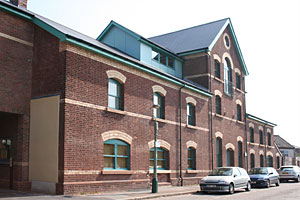 The old
brewery buildings are now apartments.
The old
brewery buildings are now apartments.
│ Top of Page │
Another name that is synonymous with brewing in Exeter, the Heavitree Brewery can be traced back to 1790. Thomas Buller Wolland's father and great uncle had been maltsters in premises opposite the site of the brewery from 1790. A bill of sale from 1828 shows Wollander purchasing 36 bushells of malt, and 28 lbs (pounds weight) of hops for a total price of £17 14 shillings. Wollander's sister, Elizabeth married the iron merchant, Thomas R Baker. In 1837 Baker sold his business and became a partner with Wollander in the brewery. However, Baker died within a few months - Wollander handed the business over to his sister, although he continued to run it for another 15 years with Elizabeth Baker as the owner.
It is thought that the brewery moved to the opposite side of Church Street in 1842, and in 1860 became Baker & Son, when Elizabeth's son Robert joined the firm. In 1861, the brewery employed nine workers, eighteen in 1871 and by 1881, twenty-three. Steady, but not spectacular progress. At his mother's death at the age of 84 in 1889. Robert Baker formed the Heavitree Brewery Ltd, to realise his assets on 7th February 1890. He remained on the board of the new company and also became active in local politics, until his death in 1911.
As soon as the Heavitree Brewery was formed, the board started to expand by acquiring public houses. One of the first was the Horse and Groom - Heavitree, on the corner of Church Street and Fore Street, Heavitree. They also purchased in the same year, the rival brewery, Crowson & Son, situated in the Windsor Brewery, off North Street. Founded in 1860 by Essex born William Crowson, who owned the Windsor Inn, the business was run by his widow and son at the takeover. They continued to brew from the premises until 1902, and closed the business in 1907, retaining the public house.
The Heavitree Brewery sunk a well in 1903 to ensure continuity of supply at a time when the mains was not so efficient as today. Brewing continued until April 1970, when it became the last in Exeter to stop production of beer. After it was taken over by Whitbread, they changed to leasing and operating public houses. The old brewery building was demolished in 1980, and replaced with the appropriately named Maltings retirement flats. The only building remaining from the old brewing business is the cooperage in Sivell Place. Many of the riginal coopers tools have ended up in Smokey Joes, a Plymouth pub.

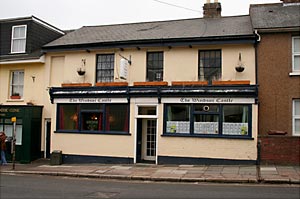 The Windsor Castle pub formerly
the Windsor Inn.
The Windsor Castle pub formerly
the Windsor Inn.
│ Top of Page │
This brewery, run by George Finch in 1878, was located at 25 North Street. It was absorbed into the Heavitree Brewery in the 20th century. See advert.
Between 1851 and 1889, William Lindsey Mortimore, who was descended from a Bradninch family, is listed as innkeeper of the Okehampton Inn. His will of 1887 refers to his ownership of a newly erected brewery and malthouse opposite the Okehampton Inn. Mortimore owned in total five inns including the Okehampton Inn, the Golden Ball in Mary Arches Street, the Anchor in Paul Street, the Duke of York in Coombe Street and the Dolphin Inn in Market Street. The inns were run by tenants and left to his children at his death. Situated in Okehampton Street, the brewery building is clearly shown on the 1876 OS map.
His son, also a William, at the death of his father in 1890, took over the brewery, now known as Mortimore's along with the Okehampton Inn. He sold the business in 1906 to William Henry Morton, the tenant of the Turk's Head in the High Street. Carr and Quick Ltd of Exeter acquired the brewery in 1909 at an auction at the Half Moon Inn. Brewing ceased in 1926.
The present Horse and Dray in Blackboy Road was once a brewery when the public house was named the George & Dragon, owned by Stevenson & Son. The brewing ceased in 1921.
Situated in the Ship, Heavitree (now the Ship and Pelican), this brewery existed circa 1885.W J Rogers, Ltd brewed from 57 and 59 Magdalen Road in 1906.
Sources - The Land of Bill Brewer, Express & Echo, Financial Times, Morning Advertiser, Trewman's Exeter Flying Post, Izacke, the Exe Island and the City Brewery by Pring, Jenkins and Hoker histories, Heavitree by Hazel Harvey, Ordnance Survey map 1876, Carl Mortimer and lastly, Steve Coombes.

│ Top of Page │